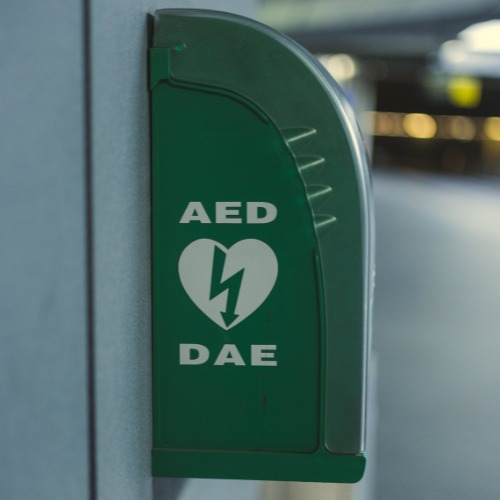Defibrillator – tricky to pronounce but learning how it works is vital. Knowing how to use one if faced with an emergency should be something everyone knows, as it could save a life. This guide will take away any mystery from these devices and give you the confidence to know how they work should you ever need to use one.
Defibrillators are special devices capable of administering an electric shock to the heart to restore its normal rhythm, to both stopped hearts, or life-threatening types of arrhythmias (irregular heartbeats). If not treated, these can result in a lack of effective blood circulation which can be fatal without a quick response.
The heart is an organ approximately the size of a person’s fist. It pumps blood around the body, supplying oxygen and nutrients. If the beating of the heart is disrupted or stopped, the electrical activity must be reset or restarted for a person to survive. A defibrillator can do this by sending a controlled electrical charge to heart muscle cells. This causes a process called depolarisation, causing a brief change from a negative to a positively charged state within the cells, causing them to contract. The opposite state, polarisation, reverses this and allows the heart muscle to relax.
We need a constant, regular flow back and forth between these two states to stay alive, as that is what makes up a heartbeat. If you have an electrocardiogram (ECG or EKG), the wave shown on the screen or printout is a measurement of these two states, which make up the electrical activity of your heart.
The charge delivered by a defibrillator is designed to abruptly shock a heart into depolarisation, hopefully allowing the heart’s natural pacemaker cells to kick back into action and restart a person’s normal heartbeat.
There are several types of defibrillators:
Automated external defibrillators (AEDs) are the most common form of defibrillator. As well as in hospitals, they are found in many public spaces and should be marked with clear signage. They can save the lives of people whose hearts have stopped beating, which is known as cardiac arrest. Public units are designed to be user-friendly so that they can be operated by people without medical training. The units contain adhesive pads that are placed on the patient’s chest, which contain electrodes. The pads are then connected with wires to the unit. The beauty of AEDs is that they contain special devices that can analyse a person’s heart rhythm to determine whether or not they need an electrical charge. If it is necessary to shock the heart with a charge, the AED guides the user through the process, keeping it as safe and effective as possible for members of the public to attempt. The guided process helps to minimise errors whilst maximising the chances of successful resuscitation.
Implanted cardioverter defibrillators (ICDs) are small devices surgically placed inside the chest. They automatically detect cardiac arrest or a life-threatening disruption to heartbeats. They then send a high-energy electric charge to correct this or restart the heartbeat. Some ICDs can also send low-energy pulses, acting in a similar way to a pacemaker device, keeping a heartbeat regular.
Wearable cardioverter defibrillators (WCDs) work like ICDs but come in the form of a vest with a battery pack. These are designed to be used for short periods of time rather than long term, like ICDs.

Why every workplace should have a Defibrillator and why Clockwise already does
So now you know how it works, do you know if your workspace has got one? An AED should be considered a vital part of the first aid equipment in any place of business.Heart and circulatory disease causes 1 in 3 deaths per year globally. In 2022, there were more than 30,000 cardiac arrests that occurred outside hospitals in the UK alone, with a survival rate of less than 1 in 10.
At Clockwise, we want everyone who comes through our doors to be as safe as possible, which is why you can find a defibrillator in most of our locations.
- Immediate help in an emergency
There’s a reason there’s a defibrillator on every crash cart in a hospital – in the event of a cardiac arrest, time matters. Should the worst happen, having quick access to a defibrillator at work can up the odds of the unlucky person surviving and reduce the chances of damage to other areas of the body from prolonged lack of oxygen.
- Improves safety for employers, customers, and clients
Unfortunately, the rate of heart disease and heart attacks is increasing, so workplaces and public spaces should be encouraged to see defibrillators as necessary equipment for the safety of everyone working or visiting.
- Provides training and communication opportunities
Installing a defibrillator is a great opportunity to provide training to employees not only in how it works but also to refresh first aid knowledge more broadly. They could also be a great internal communications opportunity to talk about heart health, starting conversations about topics such as getting heart health checked or improving cardiovascular health through nutrition and exercise.
Looking for more ways to improve your business practices? Explore a wealth of knowledge on everything from wellbeing to sustainability on the Clockwise blog.




